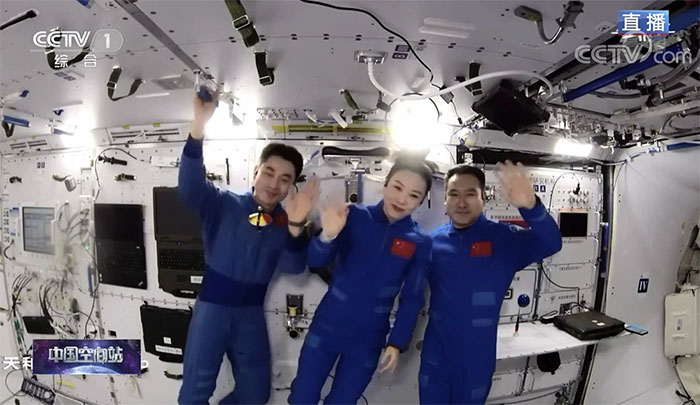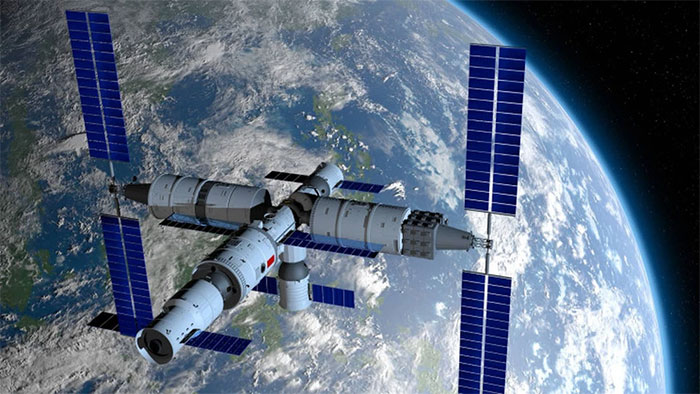Upon completion, Tiangong will become the first space station owned by a single nation in history.
China’s Clear Space Plans
China is set to complete the Tiangong space station on schedule in 2022 and will conduct two crewed space missions each year over the next decade.
Tiangong will orbit the Earth at an altitude of 340 to 450 kilometers above the surface. [In comparison, the International Space Station (ISS), originally constructed by the Soviet Union and the United States, later involved many other international partners such as Japan, Canada, and ESA].
This plan was outlined by Hao Chun, Director of the China Manned Space Engineering Office, in Beijing on Sunday, April 17, just a day after the Shenzhou 13 crew, consisting of three astronauts, returned to Earth, concluding China’s record six-month mission in space.
“The initial plan is to launch two crewed spacecraft and two cargo spacecraft each year, with astronauts on orbit at the Tiangong station for longer periods to conduct scientific experiments and space engineering,” said Mr. Hao Chun.

China plans to send two crews into space each year. (Photo: Xinhua)
According to the schedule, China will complete the construction of the Tiangong space station in its orbit by the end of 2022. A total of six missions are planned for 2022, including the launch of the cargo spacecraft Tianzhou 4 in May, the crewed spacecraft Shenzhou 14 in June, the Wentian laboratory module in July, and the Mengtian laboratory module in October.
Mr. Hao Chun stated that these three modules (Tianhe, Wentian, Mengtian) will form a T-shape to complete the construction of China’s Tiangong space station in orbit. Following this, China will continue to launch the cargo spacecraft Tianzhou 5 and the crewed spacecraft Shenzhou 15 by the end of 2022. Similar to Shenzhou 14, Shenzhou 15 will have three astronauts who will work and live in orbit for six months.
The crews for the next two missions have been trained, according to Huang Weifen, Chief Designer at the China Manned Space Agency. However, their names have not yet been disclosed.
On Saturday, April 16, the Shenzhou 13 spacecraft returned to Earth with a crew consisting of one woman and two men. They were the second crew to live and work on the Chinese space station.

The Shenzhou 13 astronauts spent six months working in space. (Photo: CCTV).
The Director of the China Manned Space Engineering Office stated that in the next ten years, China will also develop the next generation of crewed launch vehicles and crewed spacecraft with reusable capsules.
According to the engineering office, the next generation of spacecraft is being designed to carry seven astronauts at a time and will have significant improvements in payload capacity and return capabilities.
Mr. Hao Chun also mentioned that the Tiangong space station will be used for larger-scale experiments and research, ranging from space life science studies to microgravity physics, astrophysics, and Earth science.
China’s Space Industry Takes Off
To build the Tiangong space station, China has undertaken a long journey spanning decades. The Tiangong project was first approved in 1992. Notable milestones include 2003 when Yang Liwei became China’s first astronaut in space, making China the third nation in the world to independently send humans into orbit, and 2011 when U.S. lawmakers enacted a ban on NASA from directly collaborating with China or any Chinese-owned companies regarding space exploration.
This forced China to independently develop its capabilities. It self-manufactured the Long March 5B, its most powerful rocket, to launch massive space station modules into low Earth orbit. By the end of April 2021, China successfully launched the Tianhe core module, marking the beginning of its own space station construction.
One of the highlights will be the planned launch of the first large telescope for the Tiangong space station in 2023 (named Chinese Space Station Telescope – CSST, or simply Xuntian). Xuntian will be an advanced device functioning as an optical space observatory for Chinese scientists to conduct sky surveys.
The wide field of view will allow the telescope to observe up to 40% of the sky over ten years using a large 2.5 billion pixel camera. This telescope will orbit the Earth alongside the Chinese space station and may dock periodically with the crewed outpost in the future.
Chinese authorities will also explore the potential for private capital involvement in crewed missions, particularly in the construction and maintenance of the Tiangong space station.
When asked whether international tensions would affect cooperation between China and other countries, including Russia, Mr. Hao Chun stated that Beijing adheres to principles of peaceful use, equality, mutual benefit, and joint development and will pursue the use of outer space with all nations.
During a visit to the Wenchang Space Launch Site in Hainan province on April 12, Xi Jinping called for efforts to achieve “world-class standards” for China’s space launch facilities, according to state news agency Xinhua.
The Wenchang launch site is considered the main facility for China’s space station and plays a crucial role in launching heavy payloads, including the Tianhe core module of Tiangong.
The Wenchang launch site is preparing for the launch of Tianzhou 4 to continue the construction of the Tiangong station.

The Tiangong space station will have a T-shape upon completion.
Recently, according to Yang Hong, the chief designer of the space station system under the China Manned Space Program at the China Academy of Space Technology, the Tianhe module, the core of the Tiangong space station, has completed verification of critical technologies and achieved expected goals, Xinhua reported on April 17.
The Tianhe module has been in orbit for nearly a year, and all missions have been carried out smoothly and as planned, including rendezvous and docking with two crewed spacecraft and two cargo spacecraft, as well as the three-month stay of the Shenzhou 12 crew and the six-month stay of the Shenzhou 13 crew.
Since 2020, China has successfully conducted six flight missions, including the core module Tianhe of the Tiangong space station, the crewed spacecraft Shenzhou 12 and Shenzhou 13, and the cargo spacecraft Tianzhou 2 and Tianzhou 3. All six missions achieved success and met the goals of verifying critical technologies, a Chinese official stated.
The Tiangong station is likely to host international astronauts in the future. The European Space Agency (ESA) reported that astronauts Samantha Cristoforetti and Matthias Maurer trained with their Chinese counterparts in 2017 as a small step towards a potential future visit to the Chinese space station.

















































